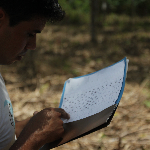Please find below the
Finalist Evaluation
Judges'' ratings
| • | Novelty: | |
| • | Feasibility: | |
| • | Impact: | |
| • | Presentation: |
Judges'' comments
- Strong proposal from a competent team, to develop analog forestry system for Peruvian Amazon ecosystem.
- This proposal has been laid out very clearly, and the objectives are reasonable. The group proposing to undertake the work has related experience. I expect that they can be successful. It's not a large impact on climate, but could be a useful example to show what can be done. Definitely worth supporting to the next level of consideration.
- (1) This proposal has a very complete list of items that has been addressed well. (2) Its current application is related to a single road that runs from Brazil on the Atlantic coast to the Pacific coast of Peru. Its emissions are not known though the proposal notes the 506 tons of CO2 from the Amazon region. Information about emissions is still not provided in the revised document.
Semi-Finalist Evaluation
Judges'' ratings
| • | Novelty: | |
| • | Feasibility: | |
| • | Impact: | |
| • | Presentation: |
Judges'' comments
Novelty: 3/5 Analog forestry is not new but is an increasingly discussed topic in the Anthropocene, to find a middle ground between untouched forests and cleared crop land.
Workability: 4/5 The proposing organization appears to have the capability to carry this through. The southern Peruvian Amazon is a good location for this development, from where it might scale up. The proposal involves a low investment for relatively high potential outcome.
Effectiveness: 3/5 A potential means to avoid full conversion of tropical forest to cropland. This proposal complements the proposal titled “Red Tree Program” which seeks analog forestry in Ontario Canada.
Thoroughness: 4/5 A fairly comprehensive proposal
Presentation: 3/5 Good but could be improved: *In the “How much emissions” section, all 506 tons of CO2e is not released—much will remain in the soil. Although it is difficult to estimate the future climate benefits of analog forestry, this is a good first effort and should be expanded to include some discussion of why analog forestry could reduce GHG emissions from the Amazon region. *In the cost section, make it more obvious what is already funded and what funding is now needed. *A time line is needed for this particular proposal (in addition to the existing timeline of the life cycle of an analog forest). *Twice in the proposal it is stated that the Peruvian Amazon is “the most important stock of GHG emissions”. The authors should distinguish between carbon stocks (held in biomass and soil) and GHG emissions (flows into the atmosphere). And what does “most important” mean?
---
(1) It is a very complete list of items that are addressed in this presentation.
(2) At the moment in the region of Madre de Dios ArBio, Peru is directly protecting 1600 hectares (16 km2) of virgin Amazon forest and carrying out research activities to identify the most promising species in terms of resilience, productivity, ecosystem services and mutualism with each other. The aim of this process is to achieve a multi-species crop model for long term production and is done in cooperation with the Universidad Nacional Agraria La Molina (UNALM, Lima). In the last four years Arbio has been working in the field of productive conservation methods and is the Peruvian representative for the International Analog Forestry Network (IAFN – www.analogforestry.org).
(3) In Peru deforestation represents 47.5% of the total net GHG emissions, which are generated mostly during fires and land use change operations in the forests. The project work will be conducted by ArBio, all its work is voluntary. Total amount of money is relatively limited at $10K.
(4) Its current application is related to a single road that goes from Brazil Atlantic coast to the Pacific coast of Peru. Its emissions are not known though it notes the 506 toms of CO2 from Amazon region.
No comments have been posted.
